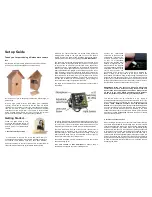
49
Installation
Appendix
Introduction
How to Use
Configuration
Definitions
■ Mode
The Network Camera offers two choices of video compression standards for real-
time viewing: MPEG-4 and MJPEG.
If
MPEG-4
is selected, it is streamed in RTSP or HTTP. There are four dependent
parameters provided in MPEG-4 mode for video performance adjustment.
■ Frame size
Select the video size. A larger frame size takes up more bandwidth. The frame
sizes are selectable in the following resolutions: 176 x 144, 352 x 240 and 640
x 480.
■ Maximum frame rate
This limits the maximal refresh frame rate per second. Set the frame rate higher
for a smoother video update.
If the power line frequency is set to 50Hz, the frame rates are selectable at the
following rates: 1fps, 2fps, 3fps, 5fps, 8fps, 10fps, 15fps, 20fps and 25fps. If
the power line frequency is set to 60Hz, the frame rates are selectable at the
following rates: 1fps, 2fps, 3fps, 5fps, 8fps, 10fps, 15fps, 20fps, 25fps and
30fps.
■ Intra frame period
Determine how often to plant an I frame. The shorter the duration, the more likely
you will get a better video update, but at the cost of higher network bandwidth
consumption. Select the intra frame period from the following duration: 1/4
second, 1/2 second, 1 second, 2 seconds, 3 seconds and 4 seconds.
■ Video quality
A complex scene generally produces larger file size, meaning that higher
bandwidth will be needed for data transmission. Therefore, if Constant bit rate is
selected, the bandwidth utilization is fixed at a selected level, resulting in mutable
video quality performances. The bit rates are selectable at the following rates:
20Kbps, 30Kbps, 40Kbps, 50Kbps, 64Kbps, 128Kbps, 256Kbps, 512Kbps,
768Kbps, 1Mbps, 2Mbps, 3Mbps and 4Mbps.
On the other hand, if Fixed quality is selected, all frames are transmitted with the
same quality; bandwidth utilization is therefore unpredictable. The video qualities
are selectable at the following settings:
Medium, Standard, Good, Detailed and Excellent.
㪎㪋㩷㪆㩷㪈㪍㪇
















































